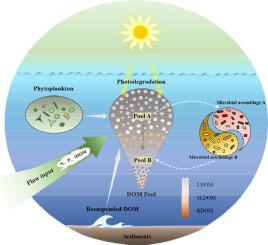Environment International ( IF 10.3 ) Pub Date : 2021-04-23 , DOI: 10.1016/j.envint.2021.106558 Qi Chen 1 , Feng Chen 2 , Michael Gonsior 3 , Yunyun Li 4 , Yu Wang 1 , Chen He 4 , Ruanhong Cai 1 , Jinxin Xu 1 , Yimeng Wang 1 , Dapeng Xu 1 , Jia Sun 1 , Ting Zhang 1 , Quan Shi 4 , Nianzhi Jiao 1 , Qiang Zheng 1

|
Dissolved organic matter (DOM) changes in quantity and quality over time and space, especially in highly dynamic coastal estuaries. Bacterioplankton usually display seasonal and spatial variations in abundance and composition in the coastal regions, and influence the DOM pool via assimilation, transformation and release of organic molecules. The change in DOM can also affect the composition of bacterial community. However, little is known on the correspondence between DOM molecules and bacterial composition, particularly through a systematic field survey. In this study, the spatiotemporal signatures of microbial communities and DOM composition in the subtropical coastal estuary of Xiamen are investigated over one and half years. The co-occurrence analysis between bacteria and DOM suggested microorganisms likely transformed the DOM from a relatively high (>400 Da) to a low (<400 Da) molecular weight, corresponding to an apparent increase in overall aromaticity. This might be the reason why microbial transformation renders “dark” organic matter visible in mass spectrometry due to more efficient ionization of microbial metabolites, as well as photodegradation processes. K- and r-strategists exhibited different correlations with two-size categories of DOM molecules owing to their different lifestyles and responses to environmental nutrient conditions. A comparison of the environmental variables and DOM composition with the microbial communities showed that the environmental/DOM variations played a more important role in shaping the microbial communities than vice versa. This study sheds light on the interactions between microbial populations and DOM molecules at the spatiotemporal scale, improving our understanding of microbial roles in marine biogeochemical cycles.
中文翻译:

时空尺度上亚热带沿海河口DOM分子与微生物群落的对应关系
溶解有机物(DOM)的数量和质量会随时间和空间而变化,尤其是在高度动态的沿海河口中。浮游细菌通常在沿海地区表现出季节性和空间变化,其丰度和组成会通过有机分子的吸收,转化和释放而影响DOM库。DOM的变化也会影响细菌群落的组成。但是,对于DOM分子与细菌组成之间的对应关系知之甚少,尤其是通过系统的现场调查。在这项研究中,调查了厦门亚热带沿海河口的微生物群落和DOM组成的时空特征,历时一年半。细菌和DOM之间的共现分析表明,微生物可能会将DOM从相对较高的分子量(> 400 Da)转变为较低的分子量(<400 Da),这与整体芳香性的明显提高相对应。这可能是由于微生物代谢物更有效的电离以及光降解过程,使微生物转化使“深色”有机物在质谱中可见的原因。由于其生活方式和对环境营养条件的不同反应,K策略和r策略师与两种大小的DOM分子表现出不同的相关性。对环境变量和DOM组成与微生物群落的比较表明,环境/ DOM变异在塑造微生物群落方面起着更为重要的作用,反之亦然。











































 京公网安备 11010802027423号
京公网安备 11010802027423号